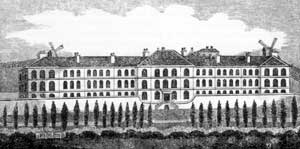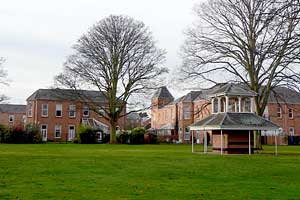
Mental hospitals
Apart from some high security hospitals, such as Rampton (near Retford) and Broadmoor, most mental health care comes under community-based mental health and social care; which means any care or support received to help you manage a mental health problem while you are living in the community (i.e. not in hospital).
The General Lunatic Asylum, St Ann’s Hospital and Saxondale Hospital
Saxondale Hospital can trace its origins back to February 1812 with the opening of the Nottingham General Lunatic Asylum. The timing of this relates to the concern over the condition of mental health care brought about by the inhumane treatment of George III during his illness of mind.

The General Lunatic Asylum, c.1815.
The Lunatic hospital’s early history is closely related to the Nottingham General Hospital. Both were charitable institutions and supported by subscriptions and donations and legacies. When the General Hospital opened in 1782 there was no provision for mentally ill persons and it was deemed a separate asylum was required. A separate subscription fund was set up but nothing happened for over three years despite Dr John Storer designating a piece of land on Bearward Lane (Chapel Bar). Fortuitously, in 1808 the County Asylum and Lunatics Act was passed which permitted local authorities to raise rates to build asylums for paupers and criminal lunatics. Land was acquired in Sneinton Field and an asylum for 80 people was built – this was based on figures from the overseers of the poor. J T Beecher played a prominent role in the design and running of the asylum. In 1810 Duke of Newcastle became president of the charity and John Storer, vice-president. The physician and surgeon were Charles Pennington and Henry Oldknow, respectively.
There were three classes of patient; private paying 15 shillings a week; partly subscribed and pauper lunatics. Staff were to behave with forbearance, tenderness, patience and humanity towards the patients – there were two keepers for five private patients and six for the 52 pauper lunatics. However, this was not always the case and problems arose from time to time. Their diet included bread, milk, meat, cheese and beer and vegetables and potatoes were added in 1850. Apparently the diet and the general cleanliness of the inmates kept disease at bay. A high wall was built around the hospital to prevent members of the public jeering at inmates.
By 1815 the hospital was overcrowded which eventually led to three separate mental institutions in Nottingham being created. In 1850 the volunteer subscribers dissolved their partnership with the local authority and decided to build their own asylum for the upper and middle classes from both town and county at Coppice Farm, known as the Coppice hospital, and opened in 1859. All pauper and criminal patients were sent to the Sneinton Asylum.
The year 1874 saw the dissolution of the Town and County venture, with the Town authorities under pressure because of growing numbers of admissions, they decided to back a separate borough asylum which was built at Mapperley in 1880. The building was designed by G T Hine, the son of T C Hine, Nottingham’s famous architect. Before 1930 when the Mental Treatment Act was passed no one could be admitted to a mental hospital except by a Justice of the Peace Order of Insanity, causing a stigma for anyone suffering from mental health issues. The idea of the new hospitals was to remove this humiliation. Work began in 1934 to extend the City Mental hospital and a new female admission hospital and convalescent villas were built on Thorneywood Lane and was known as St Anne’s Hospital. It began with accommodation for 40 patients and with 22 villas there was room for 84 patients. Wards were unlocked and were designed for long stay patients but in 1939 an outpatient clinic had been set up. The military took over the hospital during World War Two but after the inception of the National Health Service in 1948 it was merged with Mapperley, Coppice and Aston Hall hospitals under No 3 management Committee. It was also at this time that a separate children’s unit was set up at Harper Villa. Following on from this St Ann’s Hospital school was eventually opened in 1980 to accommodate 45 children which later developed into Thorneywood Child and Adolescent Psychiatry Unit based at Thorneywood.

Some of the buildings of the former Saxondale Hospital have been converted to apartments. © Copyright Alan Murray-Rust and licensed for reuse under this Creative Commons Licence
The Sneinton Asylum was used for county patients until a new hospital was planned to be situated at Radcliffe on Trent. The authorities wanted to build a purpose built, modern hospital which was opened in 1902 at Saxondale but was known as Radcliffe Mental Hospital. It proved to be very successful and more patients were admitted and new medical departments added. During the First World War it acted as Nottingham County War Hospital and existing patients were transferred to other institutions to allow military patients suffering from psychological damage to be admitted.
12 April 2022 marked the centenary of a strike led by female nurses which took place at Nottinghamshire County Mental Hospital (Saxondale, Radcliffe on Trent). The protest was against proposals by Nottinghamshire County Council to increase hours and decrease wages. After a four-hour battle the nurses were evicted.1
After the Second World War it was known as Saxondale Hospital.
During the 1980s Saxondale merged with Mapperley to form part of Nottingham Health Authority Mental Illness Unit. The merger also saw the winding up of treatment at Saxondale with all services transferring to Mapperley by 1988. There does not seem to be a specific NHS hospital for patients with mental health problems in Nottinghamshire. Following the 1983 and 2007 Mental Health Acts most of the larger hospitals have outpatient facilities, and the idea of ‘care in the community’ is the way forward.
References
1. Rosemary Collins, 'Striking Nurses Ejected from Wards after Four-Hour Battle', Nottinghamshire and Derbyshire Labour History Society Newsletter, April 2022, 1-5 [available on the Nottinghamshire Nursing History Group website]